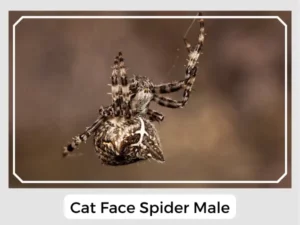The cat-faced spider, known to some as the jewel spider, thrives during the nighttime. Part of the orb-weaver family, these spiders create spiral webs shaped like wheels. Let’s discover more about this fascinating spider in this post.

Photo Credit: Werner Eigelsreiter
Tiny, round, or disc-shaped, contained in a small egg sac made of silk.
Small in size, they come out of the egg sac in 2 to 3 weeks’ time and disperse through the process of ballooning.
Yes, cat-faced spiders have venom, but it’s mostly used to immobilize their prey. The venom is generally not harmful to humans.
Cat-faced spiders can bite, but it’s rare. It might inflict a pinching bite if handled, but it often does not penetrate the skin. In any case, there is little chance of any serious health hazard as the venom they produce is harmless to humans.
The cat-faced spider plays a pivotal role in natural insect control, especially around human dwellings. Their nocturnal activities involve meticulous web construction, which inadvertently reduces the population of nocturnal insects. The presence of these spiders contributes significantly to maintaining a balanced ecosystem.
Natural Predator: The primary natural predator of the cat-faced spider is the black and yellow mud-dauber, a wasp that hunts spiders for its larvae. This interaction illustrates the complexity of food chains and the role of natural predators in controlling spider populations.
Prey-Predator Dynamics: Juveniles of this species exhibit cannibalistic tendencies, often consuming their siblings. Mature spiders feed on various insects, impacting the local insect community structure. This dynamic is essential for the balance of different species within their habitat.
Relationship with Humans: These spiders are generally seen as beneficial to humans. Often found near lights or buildings, they help reduce pest insects. Their venom poses little to no risk, making them friendly neighbors rather than pests. In fact, they are sometimes welcomed as natural pest controllers in gardens and farms.
| Lifespan | Few weeks ( Males mostly die post mating and females after producing the first egg sac) |
| Distribution | United States (Alaska, Arkansas, Arizona, Colorado, California, Illinois, Idaho, Iowa, Indiana, Kentucky, Kansas, Louisiana, Minnesota, Missouri, Mississippi, Michigan, Nebraska, Montana, Nevada, Oklahoma, North Dakota, South Dakota, Oregon, Utah, Washington, Wyoming, Wisconsin); Canada (Alberta, Manitoba, British Columbia, Saskatchewan, Quebec) |
| Habitat | Near light fixtures, around buildings, underwoods, and animal burrows |
| Common predators | Black and yellow mud-dauber (most prominent enemy), several insects and other spiders |
| Diet | The younger ones eat their siblings, while the older ones thrive on small and large insects |
These spiders serve as good pets, helping their owner keep his home and garden free of insects, especially in late summer.
In conclusion, the cat-faced spider’s intricate web patterns not only represent an engineering marvel but also serve as a testament to nature’s efficiency in pest control.
The cat-faced spider, known to some as the jewel spider, thrives during the nighttime. Part of the orb-weaver family, these spiders create spiral webs shaped like wheels. Let’s discover more about this fascinating spider in this post.

Photo Credit: Werner Eigelsreiter
Tiny, round, or disc-shaped, contained in a small egg sac made of silk.
Small in size, they come out of the egg sac in 2 to 3 weeks’ time and disperse through the process of ballooning.
Yes, cat-faced spiders have venom, but it’s mostly used to immobilize their prey. The venom is generally not harmful to humans.
Cat-faced spiders can bite, but it’s rare. It might inflict a pinching bite if handled, but it often does not penetrate the skin. In any case, there is little chance of any serious health hazard as the venom they produce is harmless to humans.
The cat-faced spider plays a pivotal role in natural insect control, especially around human dwellings. Their nocturnal activities involve meticulous web construction, which inadvertently reduces the population of nocturnal insects. The presence of these spiders contributes significantly to maintaining a balanced ecosystem.
Natural Predator: The primary natural predator of the cat-faced spider is the black and yellow mud-dauber, a wasp that hunts spiders for its larvae. This interaction illustrates the complexity of food chains and the role of natural predators in controlling spider populations.
Prey-Predator Dynamics: Juveniles of this species exhibit cannibalistic tendencies, often consuming their siblings. Mature spiders feed on various insects, impacting the local insect community structure. This dynamic is essential for the balance of different species within their habitat.
Relationship with Humans: These spiders are generally seen as beneficial to humans. Often found near lights or buildings, they help reduce pest insects. Their venom poses little to no risk, making them friendly neighbors rather than pests. In fact, they are sometimes welcomed as natural pest controllers in gardens and farms.
| Lifespan | Few weeks ( Males mostly die post mating and females after producing the first egg sac) |
| Distribution | United States (Alaska, Arkansas, Arizona, Colorado, California, Illinois, Idaho, Iowa, Indiana, Kentucky, Kansas, Louisiana, Minnesota, Missouri, Mississippi, Michigan, Nebraska, Montana, Nevada, Oklahoma, North Dakota, South Dakota, Oregon, Utah, Washington, Wyoming, Wisconsin); Canada (Alberta, Manitoba, British Columbia, Saskatchewan, Quebec) |
| Habitat | Near light fixtures, around buildings, underwoods, and animal burrows |
| Common predators | Black and yellow mud-dauber (most prominent enemy), several insects and other spiders |
| Diet | The younger ones eat their siblings, while the older ones thrive on small and large insects |
These spiders serve as good pets, helping their owner keep his home and garden free of insects, especially in late summer.
In conclusion, the cat-faced spider’s intricate web patterns not only represent an engineering marvel but also serve as a testament to nature’s efficiency in pest control.